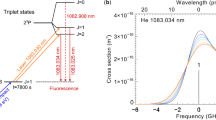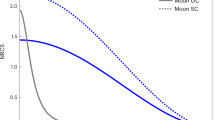Abstract
THE layer of sodium atoms present in the atmosphere at a height of about 90 km has been extensively studied by observations of the resonance scattering of sunlight in daytime and twilight1. Rocket measurements of the daytime height distribution of the resonance radiation2,3 have shown that the simple photochemical model based on the equilibrium between Na and NaO must be modified. In recent discussion of models involving a dust layer as a source of sodium4, attention has been drawn to the need for data on the night time abundance and distribution of atomic sodium. We report preliminary measurements at night by a new optical radar.
This is a preview of subscription content, access via your institution
Access options
Subscribe to this journal
Receive 51 print issues and online access
$199.00 per year
only $3.90 per issue
Buy this article
- Purchase on Springer Link
- Instant access to full article PDF
Prices may be subject to local taxes which are calculated during checkout
Similar content being viewed by others
References
Hunten, D. M., Space Sci. Rev., 6, 493 (1967).
Hunten, D. M., and Wallace, L., J. Geophys. Res., 72, 69 (1967).
Donahue, T. M., and Meier, R. R., J. Geophys. Res., 72, 2803 (1967).
Gadsden, M., J. Atmos. Terr. Phys., 30, 151 (1968).
Fiocco, G., and Grams, G., Tellus, 18, 35 (1966).
Kent, G. S., Clemesha, B. R., and Wright, R. W., J. Atmos. Terr. Phys., 29, 169 (1967).
Sandford, M. C. W., J. Atmos. Terr. Phys., 29, 1657 (1967).
McCormick, P. D., Silverberg, E. C., Poultney, S. K., Van Wijk, U., Alley, C. O., and Bettinger, R. T., Nature, 215, 1262 (1967).
Mitchell, A. C. G., and Zemansky, M. W., Resonance Radiation and Excited Atoms (Cambridge University Press, 1961).
Hirono, M., J. Rad. Res. Labs. Japan, 56, 251 (1964).
Kato, Y., and Mori, Y., Rep. Ionos. Space Res. Japan, 18, 103 (1964).
Young, R. A., Disc. Faraday Soc., 37, 118 (1964).
Nugent, L. J., Nature, 211, 1349 (1966).
Gibson, A. J., Brit. J. Appl. Phys. (J. Phys. D), 1, 933 (1968).
Soffer, B. H., and McFarland, B. B., Appl. Phys. Lett., 10, 266 (1967).
Sorokin, P. P., Lankard, J. R., Moruzzi, V. L., and Hammond, E. C., J. Chem. Phys., 48, 4726 (1968).
Bradley, D. J., Gale, G. M., Moore, M., and Smith, P. D., Phys. Lett., 26A, 378 (1968).
Ross, M., Laser Receivers (Wiley, New York, 1966).
Hunt, B. G., J. Geophys. Res., 71, 1385 (1966).
Author information
Authors and Affiliations
Rights and permissions
About this article
Cite this article
BOWMAN, M., GIBSON, A. & SANDFORD, M. Atmospheric Sodium measured by a Tuned Laser Radar. Nature 221, 456–457 (1969). https://doi.org/10.1038/221456a0
Received:
Issue Date:
DOI: https://doi.org/10.1038/221456a0
This article is cited by
-
Analysis of relative error in detection caused by signal-induced noise in Na lidar system
Science China Earth Sciences (2018)
-
A case study on occurrence of an unusual structure in the sodium layer over Gadanki, India
Earth, Planets and Space (2015)
-
Joint observations of sporadic sodium and sporadic E layers at middle and low latitudes in China
Chinese Science Bulletin (2014)
-
Sodium fluorescence Doppler lidar to measure atmospheric temperature in the mesopause region
Chinese Science Bulletin (2011)
-
First time observation of sodium layer over Wuhan, China by sodium fluorescence lidar
Science in China Series A: Mathematics (1997)
Comments
By submitting a comment you agree to abide by our Terms and Community Guidelines. If you find something abusive or that does not comply with our terms or guidelines please flag it as inappropriate.



